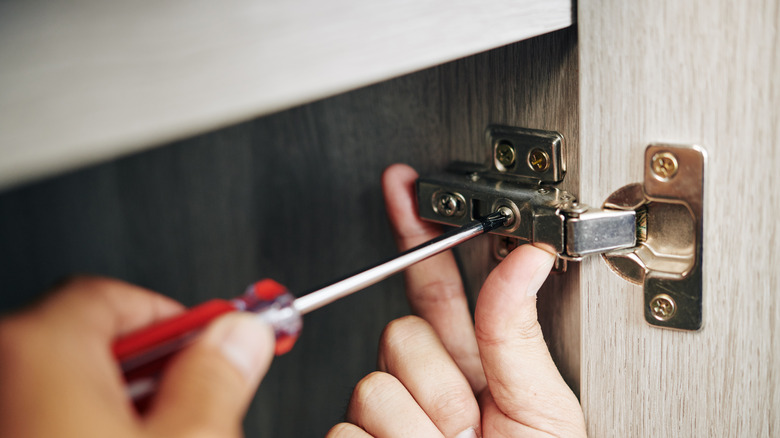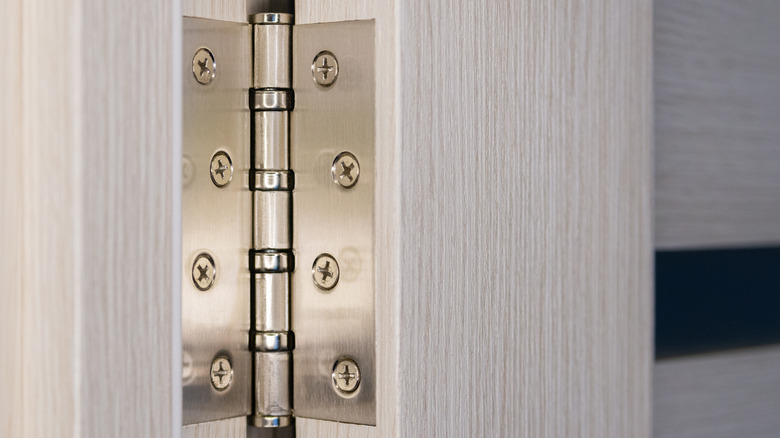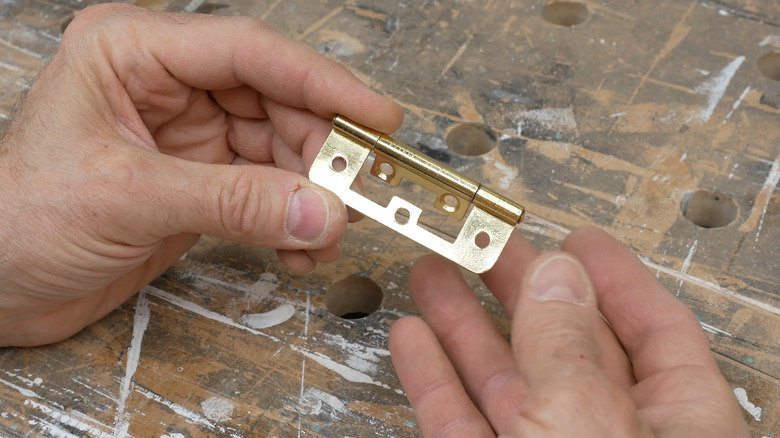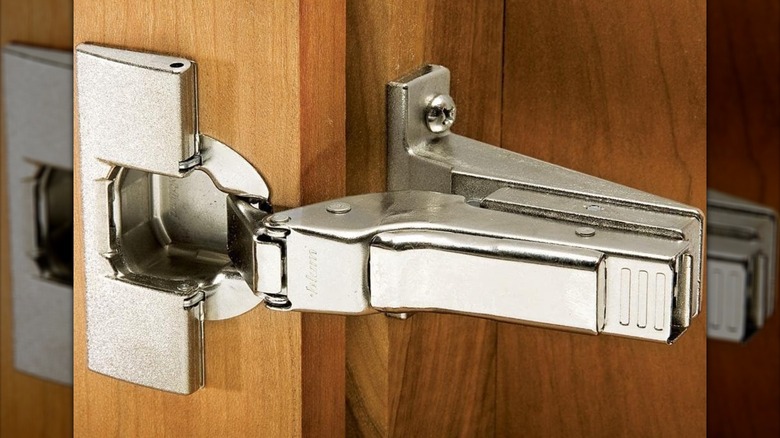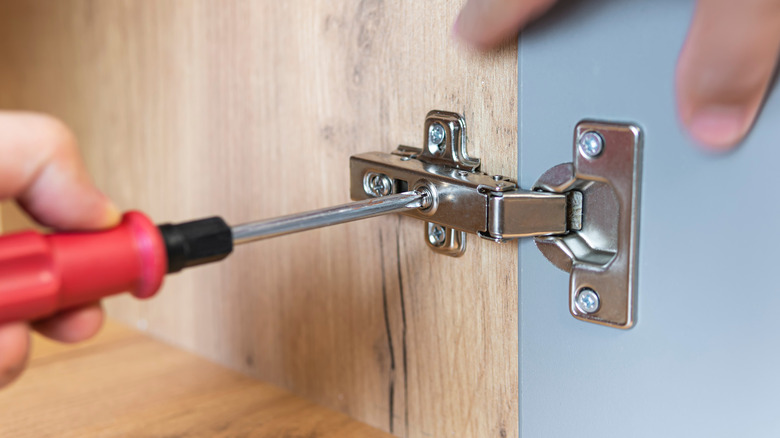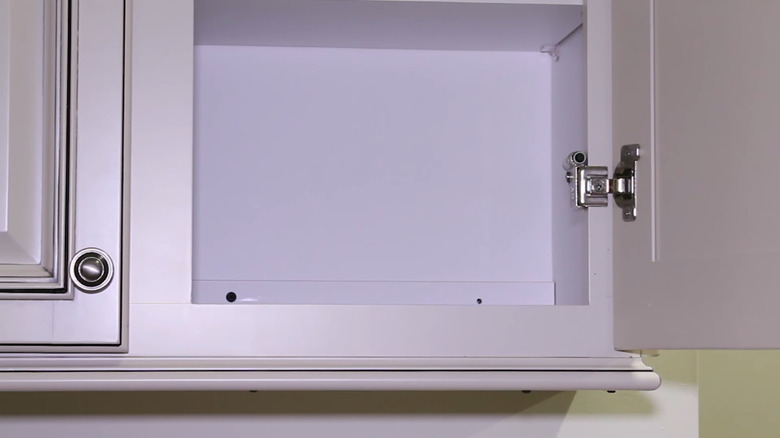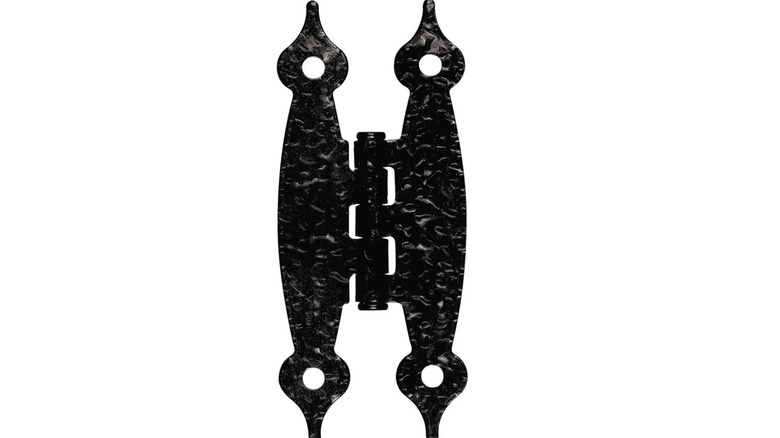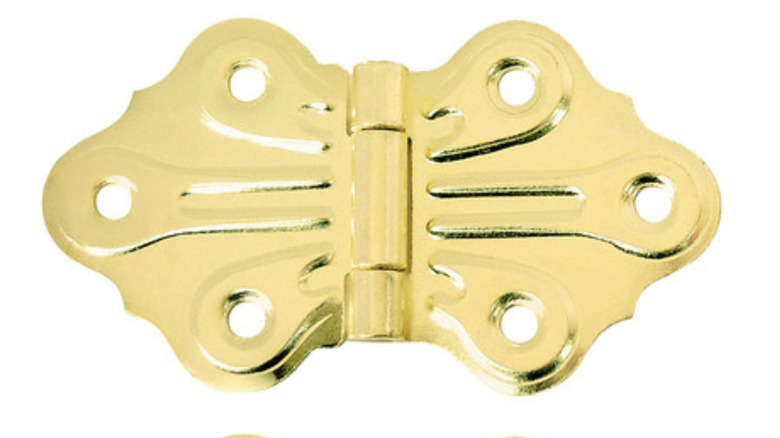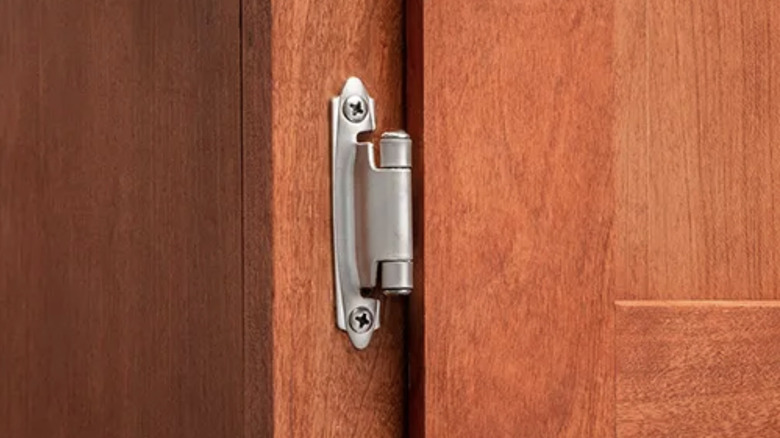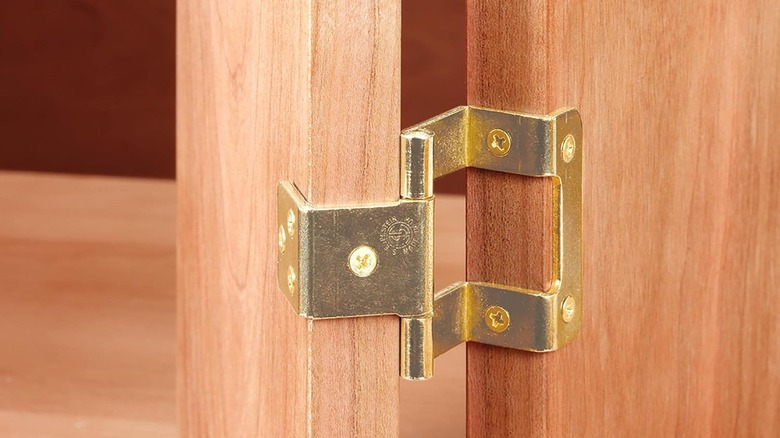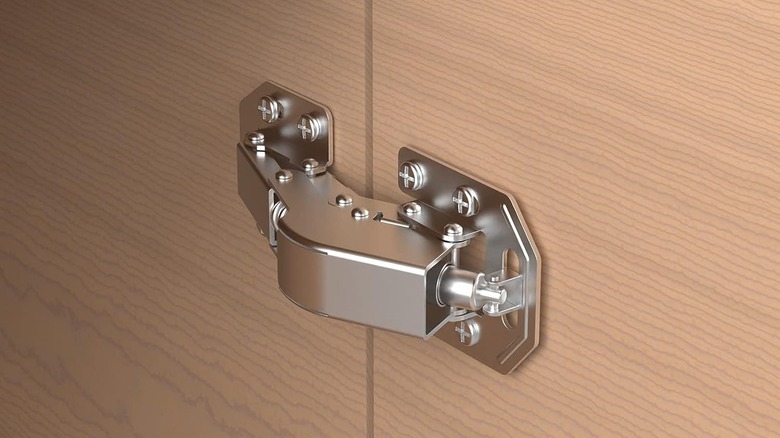Expert Cabinet Maker Explains The Different Types Of Hinges (And When To Use Them In Your Home)
We may receive a commission on purchases made from links.
Whether you're building a new home, renovating an old one, or simply adding more storage, you'll need to make decisions about cabinets. Although the hinges might seem like a minor hardware detail, they make an important contribution to both the functional and aesthetic qualities of your cabinetry. Several factors will influence which types of hinge you'll need for your cabinet doors. First, you must consider the kind of doors you have. They may be inset, partial overlay, or full overlay. The cabinet boxes may be frameless, or they may have built-in face frames. Additionally, you'll want to choose from among hinges that are invisible, partially visible, or fully exposed when the cabinet doors are closed. Which one you choose will depend not only on the aesthetic you want to achieve, but what your budget allows.
To unravel the mysteries surrounding the mind-boggling array of choices in cabinet hinges, we contacted David Tunkel, the designer and cabinet maker at Tunkel Design in the Atlanta area. He willingly shared his wisdom and insights (gained over years of experience) to explain the mechanisms and styles of various types of hinges. Read on to learn about butt hinges, European hinges, butterfly hinges, wrap-around hinges, and more.
Butt hinges are a solid option for a vintage aesthetic
Butt hinges are the most common hinges used in American homebuilding, but they are often used to hold up your interior doors rather than cabinets. That's because they are deemed old-fashioned compared to more modern, concealed cabinet hinges. They feature two matching leaves (sometimes called wings) with a pin between them to facilitate opening and closing the cabinet door. When the door is closed, only the barrel and pin are visible from the outside. However, fewer and fewer people are choosing this option because it could be rather tricky to install. "The frame and the door need to be mortised to accept the hinge. Mortising is carving or routing away some of the wood where the hinge will be," Tunkel exclusively shares with House Digest. These must be cut precisely to the dimensions of the hinge leaves, and the mortises on the cabinet box and the door must match exactly. Because of this, Tunkel says you don't usually see this hinge used on cabinets since mortising takes considerable time and skill, which will increase the cost of your project. "I have used hinges like this on cabinets before, but the intention was to give the cabinets age and history. Using hinges like this would be more appropriate on a piece of furniture," he said.
So when would you use a butt hinge? Because they are associated with a vintage aesthetic, use them if 1) you want the hinge to be exposed and 2) you want a more traditional or vintage look in your kitchen. You can also pick this option if you either have the extra budget room to pay for the mortising, or if you have the inclination and time to learn how to do it yourself. Additionally, butt hinges can only be used on inset doors, which are set into the cabinet frame and sit flush with it when closed.
The flush hinge is a slender version of the butt hinge
A flush hinge is similar to a butt hinge in that it's composed of two leaves that pivot around a pin mechanism. However, a flush hinge does not require a mortise. Instead, it mounts flush with the surface of the cabinet door and the cabinet frame. In fact, some people refer to the flush hinge as a no-mortise butt hinge. The reason it works is that the two leaves are not equal in size. One leaf is larger and features a cut-out opening into which the other (smaller) leaf fits when the door is closed. Additionally, flush hinges are typically made of thinner metal than butt hinges, making them easy to fit without chiseling out a mortise. Tunkel states, "The flush hinge is essentially the butt hinge without the mortising. The door still needs to be inset, however. You do not see hinges like this on most cabinets these days, unless you are trying to give it some furniture qualities."
Use the flush hinge if you want to install cabinets that look more like furniture, whether that means they have ornate carving, shaker-style designs, or an antique quality. You should also use this hinge if you want the classic and bygone look of butt hinges, but don't want to pay the extra expense (or take the extra time) to create mortises. They are among the easiest types of hinges to install, but they still require careful measuring, marking, and attaching with screws. Measure first and then place the hinge on the surface to carefully mark the screw holes. Next, you can drill guide holes that are slightly smaller than the screws. Then, use screws to attach the two leaves of the hinge to the cabinet door and the frame, aligning the door carefully for smooth opening and closing.
Inset full-crank hinges are perfect for invisible designs
An inset full-crank hinge is a type of European hinge. European hinges are characterized as concealed or hidden hardware because you don't see any part of the hinge when the cabinet door is closed. They contribute a clean, modern appearance to contemporary decor. "The hinge fits into a hole in the back of the door and screws to the inside of the box. The door sits on top of (not inside) the opening, " Tunkel says. European hinges require a special installation process. This includes boring a cup hole in the back of the door to accommodate the cup-shaped portion of the hinge. If you install it yourself, you can simplify this procedure by using a premade template for the precise placement of the cup hole. A DIY-friendly version of this is the Adjustable Quick Punch Cabinet Hardware Jig for $40 on Amazon. Or, if you would like something a little more professional, there is the Hinge Boring System on Amazon for $200.
You should use this hinge if you want a modern aesthetic and want the hinges completely concealed. "This style of hinge is basically the standard for cabinets these days," Tunkel shares. "There are lots of brands out there. In regard to quality, not all hinges are created equal. For this style of hinge, I tend to gravitate to Blum." You can also use these with a wide range of cabinet styles, including inset, full overlay, and partial overlay doors. You just need to get the correct version of the European hinge that corresponds with your cabinet type, which we'll get to below. The inset full-crank hinge is used for an inset cabinet, which has doors that sit flush inside the cabinet frame. The "full-crank" arm allows the door to swing open 180 degrees.
The half-crank European hinge works well for partial overlay doors
If you have a partial overlay door — which is a cabinet door that usually reveals 1/2 an inch of the cabinet's frame — use a half-crank European hinge. Much like the inset European hinge above, it attaches to the inside of the cabinet and the inside of the door. A hinge plate is attached inside the cabinet box, and an angled arm extends to the door. It's different than the inset version in that it is not installed as close to the cabinet's edge (allowing the door to create a partial overlay), and the arm doesn't bend as far.
You should choose this particular hinge if you have partial overlay doors and are designing a traditional-style kitchen, but want the hinges concealed and not exposed. The partial overlay doors are still used today because they allow you to open cabinets without knobs or pulls, as they leave space to reach under the edge of the door. This design feature might not be as popular today as it was 20 years ago, but it appeals to people who like classic and traditional designs.
The full overlay European hinge works on full overlay doors
In contrast with partial overlay cabinet doors, full overlay doors completely cover the face fronts of the cabinets. Full overlay European hinges work well for these types of doors. They have a straight arm without any bend, which allows the door to completely cover the cabinet front. Full-overlay cabinets tend to be the more budget-friendly version of inset ones, so they're a great pick for folks who want the cabinet box completely hidden but need to cut costs in their remodeling project.
You should choose these hinges if you have full overlay cabinets and don't want the hinges to show. This creates a more contemporary aesthetic, so it's perfect for people who want a modern rather than traditional kitchen. It's also a great choice if you want less hardware present with your overlay cabinets. If you want the sole focus to be on the pulls, handles, or knobs, choosing the full overlay European hinge gives your chosen hardware less visual competition.
Exposed surface mount hinges are great for antique-style kitchens
For some applications, you might want your hinges to contribute a decorative accent to the look of your cabinetry. In those cases, consider surface-mounted hardware that shows both leaves of the hinge when the cabinet door is closed. Fully exposed, surface-mounted hinges are great because you do not need to chisel out a mortise or bore a cup hole in the cabinetry to install them. One leaf is attached to the front of the cabinet door, while the other leaf is attached to the face frame of the cabinet.
Since these have been used for centuries, people who desire an antique look for their furniture or cabinets might opt for this type of hinge. They're available in a wide array of shapes and designs, using decorative metals such as brass, cast iron, bronze, nickel, and copper. Especially popular in black cast iron, the antique look of exposed surface-mount hinges evokes a medieval, Spanish, farmhouse, or mountain-cabin vibe.
Butterfly hinges add a decorative element to your cabinet doors
Butterfly hinges are surface-mounted and sometimes called dovetail hinges. They gained popularity in the Victorian era, but there is evidence that British cabinet makers used this type of hinge as far back as the Middle Ages. Although not all butterfly hinges look exactly like butterflies, they do exhibit lovely, artistic shapes that add a graceful element to your decor. A consistent characteristic of butterfly hinges is that the two leaves are exact copies of each other.
Due to the fact that these hinges are fully exposed — with both leaves showing when the cabinet door is shut — each butterfly hinge adds a bit of ornamentation to the front of your cabinetry. Use these hinges if you want to add special details to your kitchen, or if you're going for more of a Victorian style. "It's an aesthetic thing, because those plates will have some sort of shape other than just square," Tunkel explains. Use this type of surface-mount hinge with inset doors that close flush with the face frame of the cabinet. One leaf of the hinge is mounted on the front of the cabinet and the other on the outside of the door, so there is no need to chisel out a mortise.
Semi-concealed hinges are decorative, yet have modern features
When it comes to semi-concealed hinges, one leaf is attached to the outside of the cabinet frame, while the other leaf is attached to the back side of the door. When the door is closed, the outer leaf, along with the barrel-and-pin mechanism, is visible from the outside. With half of the hinge visible, semi-concealed hinges add a decorative element to your cabinetry. They're available in a wide array of metal colors and finishes. Additionally, this type of hinge offers self-closing capabilities, a handy convenience for users.
Since these are surface-mount hinges, use them if you want your hardware to show and add a decorative element to your cabinetry. You should also use them if you wish to have the self-closing convenience of a European hinge but don't want to route a cup hole or chisel a mortise. Lastly, you can only choose these if you have doors that overlay the face frame or those that are ⅜-inch inset. Semi-concealed hinges do not work with frameless cabinets or with doors that close flush with a cabinet frame.
Wrap-around hinges add extra support
Wrap-around hinges are similar to the above semi-concealed hinges since they have one leaf wrapping around the cabinet frame and the other leaf hidden behind the door. However, they differ by having an extra flap that provides added support for the door. This feature offers extra stability to keep the cabinet door from sagging over time, which makes them especially useful on large, heavy cabinet doors. Full wrap hinges provide the greatest strength, as they come in contact with three sides of the cabinet frame. By contrast, the partial wrap hinges attach to the inside of the frame, coming in contact with only two sides of the cabinet face frame. They're also versatile, since you can use them with flush, overlay, or inset-overlay cabinet doors.
You can choose these hinges for several reasons. First, they're great if you're hanging heavy or large cabinet doors that might begin to sag over time. Second, they're ideal if you want the look of butt hinges but don't want to go through the fuss of installing them. "The wrap-around hinge, and others like it, are kind of cheats for the butt hinge. They eliminate the need for the door to be inset, which saves time. And they eliminate the need to mortise, which saves time," Tunkel explains.
Soft-closing and self-closing hinges offer convenience for users
A snap-close hinge causes the door to close abruptly when it's within a few inches of the cabinet opening. However, a soft-close hinge engages a mechanism in the last few inches of closing that makes the door shut gently. As for self-closing hinges, they include built-in springs to ensure complete closure. With this type of hinge, you can give the door a gentle push, and it will guide itself to a securely closed position.
Both soft-closing and self-closing European hinges are commonly used in modern cabinetry. Their controlled action reduces wear and tear on cabinet boxes and doors to provide years of service. Use these with your kitchen and bathroom cabinet doors if you either want to keep your kitchen cabinets intact for decades (with no remodeling in sight) or if you have a lively family. The teenager who tends to slam doors without regard for noise or the bustling cook with their hands full can achieve a soft, secure closing no matter how hard they push the cabinet door.
